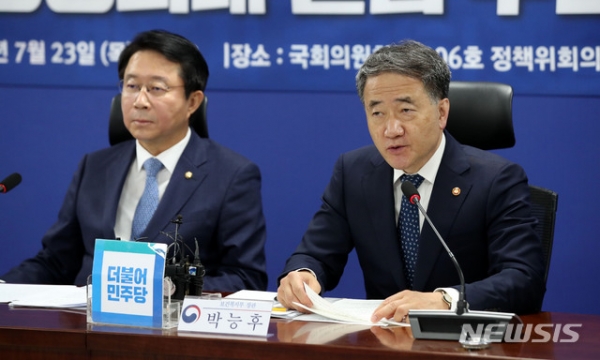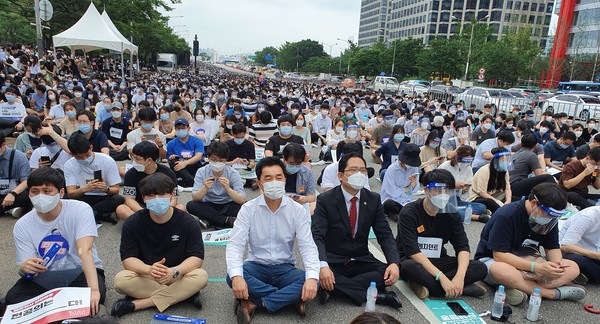One of the biggest issues in the second half of 2020 might be the doctors’ strike, which took place from August to early September. The reason why they left the hospital was because of the government’s plans for recruiting and utilizing the medical workforce. On July 23rd, the government announced plans to increase the quotas at medical schools by 4,000 over the next 10 years and to establish public medical schools to train medical personnel for the public. Kim Tae-nyeon, floor leader of the ruling Democratic Party, stressed the need to expand the number of doctors, saying that the COVID-19 pandemic revealed many problems with the health care service, including the shortage of medical workforce and regional medical gaps. However, doctors strongly protested it. As an agreement was not reached between the government and doctors, doctors’ collective action eventually broke out amid a surge in COVID-19 infections. Why did the doctors protest the policy? Are their claims reasonable?
The Government’s Medical Reform Plans

Increasing Admission Quotas at Medical Schools
The quota of medical schools has been fixed at 3,058 since 2006, down from 3,273 in 2000. The government proposed to increase the quotas by up to 400. However, the enlarged number is not permanent but temporarily maintained for 10 years. Thus, the expanded number is a total of 4,000 over 10 years. Around 300 of the extra 400 students would be ‘regional doctors’ for rural provinces. The government would waive their tuition and offer full scholarships on condition they stay for 10 years in areas that lack medical infrastructures. If they do not complete the required 10 years, they have to repay the scholarships, and their medical licenses will also be revoked. In addition, their major will be limited to subjects set by the Minister of Health and Welfare to those needed in underserved areas. Around 50 of the other 100 students would be required to specialize in fields that are less popular among medical students such as epidemiology or trauma. The remaining 50 students are raised as medical scientists such as biomedical researchers.
Establishing Public Medical Schools
The government also said that it will establish public medical schools to solve regional health care inequality. The public medical school is a kind of a medical graduate school that trains medical personnel to work in public health institutions and to provide essential public health services. The government said that it considers using the 49 medical students at Seonam University that closed in 2017. The public medical school utilizes the existing medical school quota, and there is no separate quota expansion for public medical schools.
Critics Toward the Policy
The ‘Number’ Is Not the Problem
Many doctors have strongly opposed the plans. They made various criticisms toward the policy, and their common argument was that “It is wrong to think that just increasing the number will solve the problem.” According to the Ministry of Health and Welfare (MOHW), the number of doctors per 1,000 people in Korea as of 2018 is 2.3, which is far below the OECD average of 3.5. However, doctors criticized the government that it is trying to justify expanding the medical workforce with such fragments of information alone. They have argued that the level of medical service should not be judged solely by the number of doctors, but also by health care accessibility. Kim Tae-jin, president of Busanjin-Gu Medical Association, said that Korea has a higher level of health care access than other countries in that the process of patients meeting doctors is very simple and there is no limit on the number of treatments. In fact, according to data from the National Assembly Research Service this year, the number of outpatient treatments per person in Korea was 16.6 per year, the highest among OECD countries. There were also arguments that the number of doctors is not insufficient. The Korean Medical Association (KMA) has claimed that the growth rate of doctors in Korea is the highest in the OECD, and therefore there will be an over-supply by 2040. According to data from the Korea Institute for Health and Social Affairs in 2018, the number of physicians per 1,000 people has increased by 3.1 percent annually, which is 2.4 times higher than the OECD average of 1.3 percent.
What’s Really Need Is ‘Incentive’
Doctors have claimed that improving their treatment, such as through raising medical fees should come first, not increasing the number of doctors. Medical fees are the cost paid to the provider of medical services, which consist of the patient’s deductible and insurance. The medical community has long appealed to the government to raise medical fees. This is because the medical fees they get paid were far lower than the cost price of the treatment. Shin Dong-wook, a professor at Sungkyunkwan Medical Schools, pointed out that if there is no corresponding compensation for the difficulties in the fields such as trauma center where emergency or medical disputes are likely to occur, doctors have no choice but to avoid such fields. The typical compensation is raising medical fees. Yang Dong-ho, president of Gwangju Medical Association, said that medical fees for such less popular fields are currently very low.
Where Is Personal Freedom?
The so-called ‘regional doctor system’ that makes doctors stay at provincial areas for 10 years could violate the Constitution’s ‘freedom of occupation’ and ‘freedom of movement’ clauses. In fact, doctors decide their specialties when they are residents after graduation. However, regional doctors whose major is restricted by the system would lose the opportunity to choose majors. Doctors also claimed that it is a violation of freedom of movement to work in provincial areas where the infrastructure is relatively poorer than Seoul for 10 years. According to the survey by the KMA June this year, about 71 percent of medical personnel in underserved areas said that they actually live in other areas due to their children’s education or living conditions. The KMA said that this result showed that some incentives for doctors to voluntarily choose provincial areas are urgently needed.
Are the Doctors' Arguments Reasonable?
Many doctors protested the policy, but their arguments were also controversial. First of all, the main problem that the government tries to solve through the policy is regional health care inequality. The fact that Korea's medical inequality is severe has already been proven by various statistics. According to the MOHW, while Seoul (3.1) had the highest number of doctors per 1,000 people as of 2019, North Gyeongsang Province (1.4) and South Chungcheong Province (1.5) were far below that. Also, the time for the mothers to reach a medical institution that has a delivery room was an average of 3.1 minutes in Seoul but was 42.4 minutes in South Jeolla Province, which was nearly 13 times the difference. Meanwhile, it is also revealed that the absolute number of doctors in Korea is insufficient, contrary to claims of the opposite. Tchoe Byongho, a professor at the University of Seoul, said that “the number of medical graduates per 100,000 people in Korea is 7.6, while the OECD average is 13.1, and therefore the government should actively intervene to expand the number of doctors.” Besides, the doctor’s argument is not convincing that there is no need to increase the number of doctors as Korea’s growth rate of doctors is at the highest in the OECD. It is a mathematically natural fact that small denominators increase the rate of increase. In other words, because the figure of 2.4 per 1,000 people, or the denominator is small, the growth rate of doctors is bound to increase.
Doctors have claimed that incentives such as raising medical fees are needed. But there were also critics of the claim. Jeong Hyoung-sun, a professor of the Department of Health Administration at Yonsei University, pointed out that “Doctors price the cost of treatment by setting their own labor costs.” The cost of treatment usually consists of labor costs, material costs, and administrative costs. According to the Korea Health Industry Promotion Agency, 44.3 percent of the cost of treatment as of 2016 is labor costs. In other words, doctor’s claim that the medical fees are lower than the cost of treatment actually can be interpreted that doctors' labor cost is set at a higher cost, making the medical fees seem relatively lower. Meanwhile, in the case of wages, a typical incentive, Korea currently averages higher wages for doctors than other countries. According to OECD statistics, the gap between the labor costs of ordinary workers and doctors in 2016 in Korea was 5.45 times while the OECD average of 2.75 times.
Doctors’ Strike

Doctors, who protested the government’s push for the policies without sufficient discussion, finally went on strike. Starting with the Korean Intern Resident Association (KIRA) on August 7th, the scale of the strike grew as the KMA joined the strike on the 14th. On the 21st, trainee doctors working at essential medical fields including emergency rooms also went on strike. The government responded strongly. On the 13th, a day before the KMO’s strike, Health and Welfare Minister Park Neung-hoo said, “The medical reform plan is a matter to be discussed with the government, and it has nothing to do with the patient”, and requested “please halt the strike at the risk of patients’ sacrifices.” However, their boycott to attend patients continued, and the government finally issued back-to-work orders to striking doctors on the 26th. On the 28th, it also accused 10 trainees of violating the order, which prompted more resistance from doctors. Professors from 40 medical schools nationwide issued a series of statements that they will protect their students. Among them, the Faculty Council at Hanyang University College of Medicine criticized the government in the statement that they can’t understand accusing those who have been fighting COVID-19 on the frontlines over the past few months.
However, the response of the public to their walkout was not very positive. According to a survey released by polling agency RealMeter on September 3rd, 38.6 percent of the respondents agreed to the strike and 55.2 percent disagreed. Many people criticized that doctors are protecting their own rights rather than those of patients in the current situation where people need medical staff more than ever. In fact, in August, when the strike was in full swing, the spread of the COVID-19 was more serious, even reporting over 300 new cases a day. The strike also resulted in death. A man who collapsed due to poison in Busan on August 26th failed to find a hospital to be treated and eventually died after three hours. According to the TBS report on the 28th, the paramedic said that hospitals refused him due to the absence of medical staff. As the peoples’ suffering from the strike grew, the Democratic Party and the KMA eventually agreed to go back to square one and review the policy after COVID-19 stabilization.
On September 6th, even the KIRA, which had pushed the collective action despite the agreement between the government and KMA, ending the nearly month-long strike. But the social discussion of this situation remains. First, the government, which pushed ahead with the policy without sufficient agreement, is primarily responsible for the situation regardless of whether the policy is right or wrong. Also, as many have pointed out, the supply-oriented policy needs to be improved. Meanwhile, the doctor’s strike at a time when public safety was at stake was enough to be criticized as ‘selfish.’ Was adding doctors such a desperate reason for the strike to such an extent that they close the emergency room and turn away patients? No strike is held at the risk of people's safety and lives. As there are also many voices refuting their claims, doctors need to present alternatives that many people can sympathize with, rather than only focusing on criticizing the policy.

